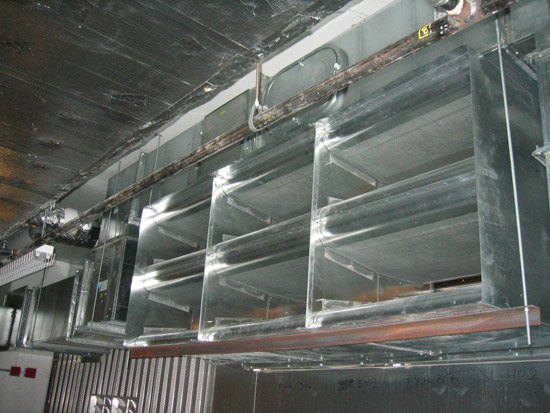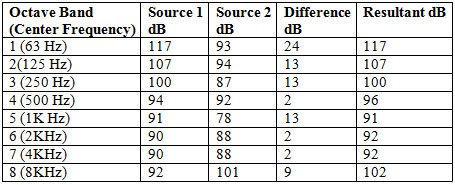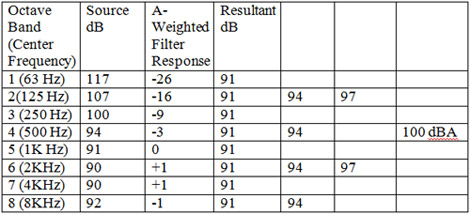This CE Center article is no longer eligible for receiving credits.
Continuous or intermittent noise from an insufficiently designed HVAC system is disruptive and distracting. In many instances design professionals focus on delivering the proper airflow, but ignore acoustical aspects, often assuming that white noise from mechanical systems is beneficial because it helps mask other noises within the work environment.
A noise reduction/abatement program is essential for many industries, especially manufacturing facilities, because of safety and potential claims for hearing damage. In offices, acoustic problems are both a leading source of employee dissatisfaction and the least addressed in office designs (General Services Administration (GSA) workplace research (Sound Matters, January 2012)). Today, owners, designers, developers and insurers of all building types are increasingly aware that HVAC noise can contribute to litigious health issues for both occupants and neighbors. Addressing the acoustical aspects of air handling systems is equally critical as meeting air flow heating and cooling design requirements.
In order to analyze, evaluate and remedy—if necessary—HVAC acoustic issues, several steps are necessary. The first is to analyze the entire duct system. This begins by evaluating the natural attenuation that occurs in HVAC systems. If undesired sound persists despite natural attenuation efficient and cost effective acoustical remedies need to be specified. Leading noise control product manufacturers offer no-cost design and engineering assistance in analyzing duct systems (see example of a web-based program below), but it behooves design professionals to have an understanding of the concepts underlying HVAC noise control. Such an understanding will also help during the design phase when natural attenuation strategies can easily be incorporated.
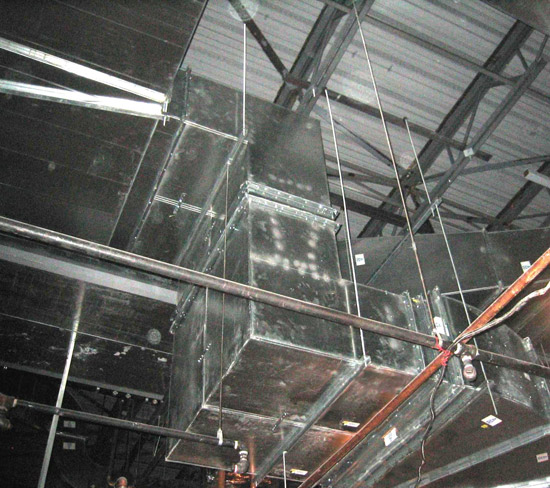 |
Sound attenuators for HVAC systems
Photos courtesy of Kinetics Noise Control, Inc. |
Basic Acoustic Concepts
Knowledge of duct system acoustics is an essential first step.
Sound Power and Sound Pressure
While sounding similar, they are different. Sound power is the amount of acoustical power generated by a sound source in all directions. It is expressed in watts and cannot be directly measured but can be calculated based on sound pressure measurements. Sound power level (abbreviated as PWL or Lw) is a logarithmic measurement of the sound power.
Sound pressure is the fluctuation of the ambient pressure generated by the vibration of a surface that creates a sound wave. It is measurable and expressed in the sound pressure unit pa, or pascal. Sound pressure varies according to the magnitude of the sound source, the location of where the sound is measured, the density of the medium the sound travels through and the directional path the sound travels. The reason why the sound of an electric drill operating in different locations varies is because the sound pressure varies, despite the fact that the sound from the drill is constant.
The range of sound power is huge: a faint noise at the lower level of human audibility is 1x (10)-12 (0.000000000001) watts, while the sound power of a space shuttle launch is 1 x (10)8 (100,000,000) watts. Normal speech is 1 x (10)-5 (.00001) watts. A soft whisper is 1 x (10-9) (0.000000001) watts.
Similarly, sound pressure can range from 2 x (10)-5 (0.00002) pascal to 1 x (10) (100,000)5 pascal. Normal speech at 3 feet is 2 x (10)-2 (0.02) pascal. For convenience and the fact that we cannot hear variations in sound unless there is a large difference in sound pressure, a logarithmic definition of sound power and sound pressure is used. To accommodate such a large span in values, a decibel (dB) is defined as each successive whole number being 10 times larger than the previous number based on a reference point of 20µPascals (20 x 10-6 pascal). This reference is considered the low threshold of human hearing. Sound pressures are directly measured by a pressure transducer or microphone, which converts pressure to sound pressure levels. Sound Pressure Level (abbreviated as SPL or Lp) is a logarithmic measurement of the sound pressure.
Sound Pressure Level is defined by the equation Lp = 20 log10 (p/pref) which results in a dB value with (pref=20µPascals).
Sound Power Level is defined by the equation Lw = 10 log10 (p/pref) which results in a dB value with (pref=10-12 watts).
Note that sound pressure levels are a measurement of pressure where sound power is a measurement of energy.
The unit for both sound power level and sound pressure level is the decibel (dB), which expresses our subjective reaction to noise, or how we perceive sound. Because sound levels are expressed in logarithmic terms, a small change in decibel level is significant in how we hear and perceive that sound.
Calculating sound pressure levels is critical to acoustical analysis because that relates to what sound people will hear.
Since sound power (energy measurement of the sound source) and sound pressure (pressure measurement of the sound we hear) are different, their values in decibels are also different. See Table of Typical Sound Pressure Levels (Lp).
Table 2. Typical Sound Pressure Levels (Lp)
 |
|
Table courtesy of Kinetics Noise Control, Inc. |
| Important Points to Remember |
• Never specify acoustic treatment without first analyzing both the supply and return air critical duct system paths.
• Doing so will result in an improperly designed system that introduces unnecessary costs to the owner.
• Avoid over-designing acoustic treatment by considering natural attenuation.
• Often natural attenuation is sufficient to reduce noise levels to acceptable limits.
* A proper acoustic design goal is to achieve a comfortable acoustical environment not to achieve the lowest possible sound level in a critical space.
* Do not over-attenuate high frequencies. A rumble noise problem will be created.
• Do not over-attenuate low frequencies. A hissing noise problem will be created.
* Some background noise levels can be helpful for speech privacy and masking other noise sources. Identify the use of areas to determine appropriate acceptable noise levels.
|
Combining Sound Levels
Because sound levels are logarithmic, and based on different reference points sound power and sound pressure cannot be directly combined.
A doubling or halving of a sound pressure level will not be perceived as a doubling or halving the level of noise we hear. Rather, since the values are logarithmic it only takes a small change in a sound pressure level to perceive a large change in sound subjective perceptions:
• A change of ± 3 dB is not detectable
• Most people notice a change ± 5 dB
• An increase +10 dB is perceived as a doubling of sound
• A decrease of -10 dB is perceived as a halving of noise
Instead of employing extensive calculations in order to compute sound levels, i.e., what sound will we actually hear if we are exposed to more than one sound source at the same time, it is possible to use short-cut, rule of thumb guidelines:
• Adding a sound source that is 10 dB less than a primary sound source will have no effect on the overall level of sound perceived. The louder sound source masks the quieter source.
• The addition of two equal sound sources will result in a noise level increased by 3dB.
• The addition of sound sources which differ by 2 dB to 4dB will increase the louder noise source by 2dB
• The addition of sound sources which differ by 5dB to 9dB will increase the louder noise source by 1dB
(See Table Simplified Decibel Additions).
Table 3. Guidelines for Simplified Decibel Additions
 |
|
Table courtesy of Kinetics Noise Control, Inc. |
Example: Two sound pressure sources producing 100 dB each do not produce 200 dB when heard together. Rather, according to sound pressure equations, the subjective combined sound pressure level is 103 dB.
Frequency
The frequency of a sound is determined by the number of pressure fluctuations (sound waves) produced per unit of time. Fluctuation in pressure determines the pitch. Sound frequency can be correlated to pitch and is measured in Hertz (Hz), cycles per second. Humans have the capacity of hearing sounds that range from about 20 Hz to 20,000 Hz. Middle C on a piano has a frequency of approximately 260 Hz. One octave above or below has double or half the frequency of middle C.
Noise control is a function of the frequency of the noise source. Frequencies are important because they can be grouped together into octave bands.
The overall decibel level from combining sounds from 8 octaves, or bands, can be calculated using the rule of thumb table. See the following four tables for Octave Band Linear Addition
Table 4. Octave Band Numbers and their Center Frequencies
Table 5 and 6. Octave Band Center Frequency Linear Addition
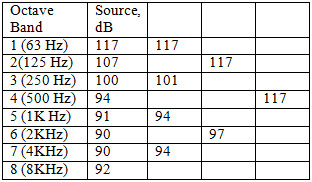 |
Example of octave band center frequency linear addition combining two noise sources using rule of thumb guidelines from Table 3 Simplified Decibel Additions.
Tables courtesy of Kinetics Noise Control, Inc. |
Wavelength
The wavelength of sound is the distance over which the wave shape repeats. Low pitch sounds have long wavelengths. High pitch sounds have short wavelengths. Wave length is important as it directly relates to frequency and helps determine the proper product required to control the noise. The best noise solution is to select a product that allows for multiple wavelengths to pass through the product. The short wavelengths associated with higher frequencies (i.e., 1K , 2K , 4K and 8K Hz bands) of Table 7 make it easier to attenuate noise at these higher frequencies.
Table 7. Wavelengths of Octave Band Center Frequencies
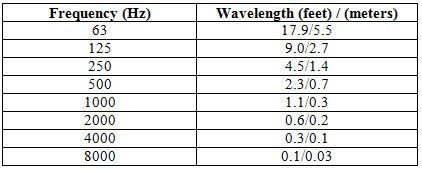 |
|
Table courtesy of Kinetics Noise Control, Inc. |
Loudness
Loudness, a subjective measure, is an attribute of auditory sensation. It is a function of frequency and sound pressure level. However, the frequency of a sound will have substantial bearing on how loud the receiver perceives it to be. Equal loudness contours have been developed which show the increase and decrease in sound level energy required at various frequencies for the average human to perceive sound in a particular frequency as sounding just as loud, say, as that of a 20 dB sound pressure level at 1000 Hz.
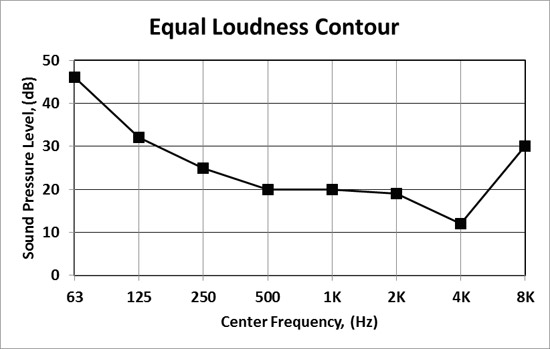 |
Loudness is a function of sound pressure and frequency.
Provided by Kinetics Noise Control, Inc. |
A-Weighting
Weighting is a useful means of adjusting a linear noise spectrum to closely reflect the human ear response. An A-weighting filter on the sound meter is commonly used to emphasize frequencies from 1000 to 8000 Hz where the human ear is most sensitive, while attenuating very high and very low frequencies to which the ear is less sensitive.
Human beings are so sensitive to sound in the 2,000 Hz to 4,000 Hz levels that A-weighting, the most common weighting system, actually increases those levels to more closely reflect the human ear response. The basis is equal loudness contours. Adjustments are made in all frequencies except 1000Hz. Once adjustments are made, decibel addition can be used to yield a single “A-weighted” sound pressure level (dBA).
Table 9. Example of A-weighting using rule-of thumb guidelines.
Since A-weighting accounts for the sensitivity of human hearing and it is a relatively simple metric, Occupational Safety and Health Administration (OSHA) has adopted it to set limits on noisy work environments. Specific requirements and guidelines may be found in OSHA Standard 29CFR, Part 1910, Subpart G “Occupational Health and Environmental Control.”
Table 10. Federal Noise Limits (OSHA)
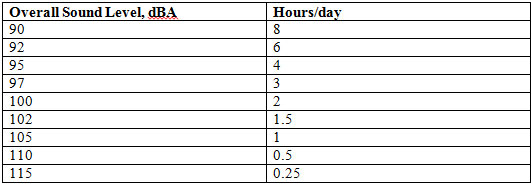 |
|
Table courtesy of Kinetics Noise Control, Inc. |
Duct System Acoustics
In order to determine if a duct system requires additional attenuation, all the duct components along the critical duct path must be analyzed. This analysis starts with the fan sound power levels (per octave band) and ends with the sound absorption or reflection effects of the receiving room.
Design professionals should be aware that there are multiple noise propagation paths that should be considered: the noise that travels through both the supply and return duct system paths, and the airborne noise that radiates away “breaks out” through the walls of the duct into the neighboring spaces.
Fan Noise
Fans generate the primary noise source in HVAC systems. Fan manufacturers can provide laboratory test results for the total sound power levels of the fan that includes the fan inlet, discharge, motor drive train and casing radiated noise. Testing is conducted according to Air-Movement and Control Association (AMCA) Standard 300, “Reverberant and Room Method for Sound Testing of Fans.” AMCA, a trade organization comprising fan, damper and silencer manufacturers, specifies test methods and requirements so that all members use the same rating guidelines. Similar test methods are published by the International Organization for Standardization (ISO) and the American Society for Testing and Materials (ASTM).
Sound level data from fan manufacturers may be either total fan sound power levels or separated into inlet sound power level and discharge sound power levels. The most important data concerns the noise propagating inside and along the duct system paths. If the sound power level is only given as a total sound power level the rule of thumb is to subtract 3 dB from the total fan Lw for each octave band. This is true for both stand-alone fans as well as for packaged air handling units.
Noise from Packaged Air-Conditioning Equipment
Design professionals should obtain manufacturer’s noise data from tests conducted in accordance with Air-Conditioning and Refrigeration Institute (ARI) Standard 260.
Controlling Fan Noise
Fans should be selected to operate near their maximum efficiency. Fans are noisier when they are either oversized and operating under design speed, or undersized and operating above design speed.
Duct system components can both attenuate and generate noise as sound and air propagate through the system. The following discusses some of these more prominent affects.
Natural Attenuation
Single-wall duct system components provide natural sound attenuation. Several mechanisms such as duct wall losses, elbow reflections, sound power splits and terminal end reflections may serve to provide significant natural attenuation sufficient to reduce noise levels to acceptable limits. Natural attenuation could also eliminate the need for expensive energy consuming supplemental products and should be the first step in acoustically analyzing a duct system.
In-duct Single Wall Duct Attenuation
When sound travels through a duct system, some of the sound energy is transmitted to the duct surface. This will cause that duct surface to vibrate and dissipate some of the sound energy. The amount of energy dissipated through the walls of a duct is a function of the shape, size, length and the frequency of the sound.
The reduction of in-duct sound energy, which is dissipated through natural duct attenuation is expressed in units of (dB/ft). Long duct lengths have significant amounts of attenuated sound energy.
Natural duct attenuation assumes that the duct walls are massive enough to contain most of the in-duct noise. Also, that the sound energy is transferred to the duct surface and converted into vibration of the duct wall material. See the following two tables for natural sound attenuation through round and rectangular ducts.
Table 11. Natural attenuation-straight circular sheet metal duct.
 |
|
Table courtesy of Kinetics Noise Control, Inc. |
Table 12. Natural attenuation—unlined rectangular sheet metal duct.
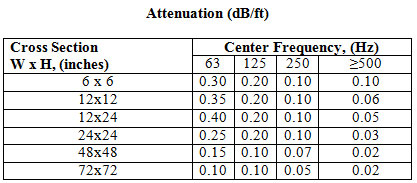 |
|
Table courtesy of Kinetics Noise Control, Inc. |
Elbow Attenuation– Reflection
When sound energy enters an elbow, part of the sound wave is attenuated through reflection. The amount of attenuation is proportional to the elbow bend angle and frequency of the sound. It is expressed in dB/elbow per frequency.
Table 13. Insertion Loss (attenuation) of Radiused Rectangular Elbows (dB)
Sound Power Splits
The most significant mechanism of natural attenuation is sound power splits. Airborne sound power energy in watts behaves the same as air when approaching a divided-flow fitting—it divides or splits. The division of sound energy at a junction will be proportional to the cross-sectional area of the downstream path of the flow divided by the total of all the cross-sectional areas of the downstream flow paths.
For example, sound energy moving through a 12-in. common duct with a 5-in. branch and an 11-in. straight-through will be split into the following ratios: branch duct: 0.17; main duct: 0.83. Meaning that only 17 percent of the sound energy entering the fitting will propagate down the branch and the balance will travel straight-through.
Table 14. Natural attenuation sound power reduction.
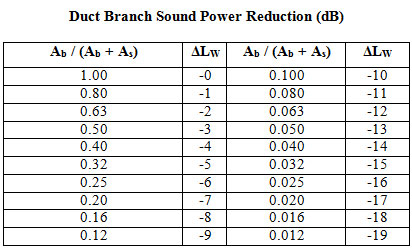 |
|
Provided by Kinetics Noise Control, Inc. |
Ab is branch cross-sectional area
As is the straight-through cross-sectional area (downstream)
Lw is sound power level in dBs.
Terminal End Reflection
Terminal end reflection is effective for attenuating low frequency energy. At the termination of a duct path, a portion of low frequency power wave energy is reflected back into the duct.
Table 14A. Duct end reflection loss when duct is terminated in free space.
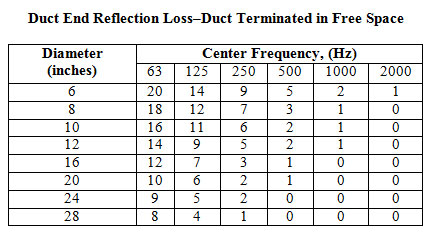 |
|
Provided by Kinetics Noise Control, Inc. |
End reflection attenuation is virtually negated if a variable air volume (VAV) system, diffuser/grille is placed at the duct opening.
Airflow-Generated Noise
Air flowing over duct surfaces generates noise. The following airflow conditions should be avoided:
* High face velocities:
Greater than 2,000 ft/min for rectangular duct
Greater than 3,000 ft/min for round and flat oval duct
It is recommended that acoustic analysis calculations include airflow-generated noise for all duct elements, along the critical path. This includes the sound power levels of fan powered VAV boxes. Generated sound power levels should be compared to the resultant levels after subtracting all pertinent attenuation. If they are within 10 dB of the resultant value of any octave band, they will contribute to the overall noise level.
Radiated “Break-out” Duct Noise
“Break-out” noise is noise that radiates from the duct system elements to surrounding spaces. It is an important design parameter whenever a duct system runs through or over an acoustically sensitive space. This noise will most likely be a problem if the localized in-duct sound power level at any frequency, minus the duct wall transmission loss, exceeds or is within 3 to 5 dB of the NC level of the acoustically sensitive space. This is best addressed during the initial design of the duct system.
“Break-in” Noise
Ambient noise transmitted into a duct is known as “break-in” noise. This noise can be ignored if in-duct noise is 10dB or greater than the break-in noise. But at places where the fan and aerodynamically generated noise are minimal, significant levels of break-in sound can radiate from surrounding areas to inside the duct and propagate to critical places along the duct path.
Room Acoustics
After logarithmically combining the attenuated sound power levels with the airflow generated sound power levels, the next step is to determine the sound pressure levels within the critical space (i.e. office, conference room, sanctuary, etc.). This is done by taking the sound power levels remaining at the supply air diffuser or return air grille and converting them to sound pressure—taking into account the acoustic effects of the room (i.e. sound absorption and sound reflection). The resulting sound pressure levels will be used to determine whether HVAC sound is within acceptable/specified design criteria, or if attenuating strategies need to be employed.
Air Terminal Noise
Duct system paths generally terminate at a register, diffuser, grille or other device. Because terminal devices generate noise as a result of air passing across them, it is necessary to calculate the sound power level of that noise before addressing the entire room duct system. Noise generated from diffusers/grilles is critical because it is the last noise source that affects sound levels in the critical space.
Acoustic and airflow test data are usually generated in accordance with ASHRAE Standard 70 “Method for Testing for Rating the Performance of Air Outlets and Inlets.” If the diffuser sound power is within 10 dB of the residual sound power in the duct, it will increase the sound power level emitted in the space.
ASHRAE Room Effect Equation
As mentioned, sound power levels (Lw) and sound pressure levels (Lp) cannot be directly combined. Therefore, in order to calculate sound pressure levels resulting from sound power emanating from HVAC duct terminals, a procedure endorsed by ASHRAE may be used. The procedure assumes that rooms have normal sound-absorbing surfaces and furnishings. Other formulas are available for special rooms (i.e., rooms that are more absorptive, “recording studios” or rooms that are more reflective, “gymnasiums”).
Design Criteria
Having accounted for fan sound power levels, natural duct and fitting attenuations, generated duct, fitting and terminal noise, and converting sound power levels to sound pressure levels for a specific space, the next stage is to determine whether the sound pressure level meets the acoustic design criteria. Various criteria have been established for different space occupancy situations.
Indoor Noise Criteria (NC)
NC curves establish the desirable background sound pressure levels in a critical space. Because higher frequencies are perceived louder than lower frequencies of the same dB level, NC curves allow higher dB levels at lower frequencies. The NC criteria consist of a family of curves that define the maximum allowable octave-band sound pressure level corresponding to a chosen NC design goal. They primarily apply to the noise produced by a ventilation system, but they may be applied to other noise sources.
Measured Lps within a critical space can be plotted against standard NC curves to determine compliance with specification or to rate the noise within the critical space. The appropriate NC curve for a given space is that lowest NC curve that is closest to the highest noise spectrum sound pressure level at a particular frequency.
Table 15. Typical indoor design acoustical goals using NC curves
 |
|
Provided by Kinetics Noise Control, Inc. |
NC Curve Plot
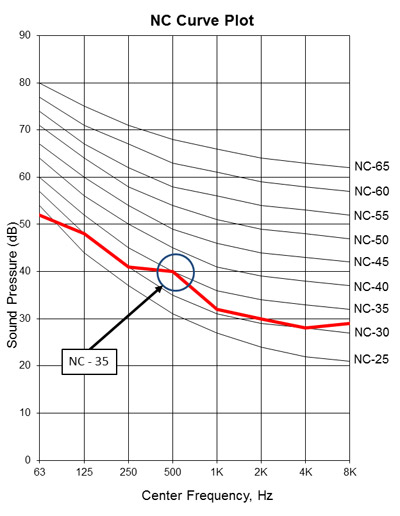 |
Allowable Sound Pressure Level (dB) per Frequency vs. NC Level
Provided by Kinetics Noise Control, Inc. |
Methods of Acoustical Treatment
Acoustic remedies are required if the sound pressure levels within the critical space exceed the sound pressure levels per frequency of the corresponding NC or RC curve. The most common acoustic attenuation method for HVAC duct systems is to install a silencer (i.e., sound attenuator or sound trap).
Silencers
A silencer attenuates sound when it is directly inserted in the ducted air stream (path). The silencer is basically a series of perforated sheet metal baffles (rectangular silencers) or bullets (circular silencers) placed inside a silencer single or double wall outer solid shell. The baffles/bullets are usually filled with sound absorbing material.
Acoustic performance of duct silencers is generally described in terms of “insertion loss”—the measure of noise level reduction determined by comparing the noise level without a silencer to the noise levels with silencer. Since the silencer itself can generate noise (because it disturbs the airflow), its self-generated noise has to be added to the attenuated sound level. Baffle and bullet-type silencers block a portion of the air stream and will cause additional pressure drop (PD). Manufacturers should always list values for insertion loss, regenerated noise and pressure drop.
An absorptive silencer is the most common type of silencer. It uses absorptive fibrous material within sound baffles or sound bullet cavity with perforated sheet metal facings that allow sound energy to pass through and be absorbed by the fibrous fill.
Rectangular and circular silencers have solid rounded nose cones on the air inlet end and tapered tails on the air discharge end of each baffle/bullet to minimize silencer pressure drop. The tapered end of the silencer baffle/bullet allows for static regain to occur, thereby offering the lowest silencer pressure drop for a particular level of attenuation. This is important because silencer pressure drop is in direct relation to a duct system’s lifetime energy costs.
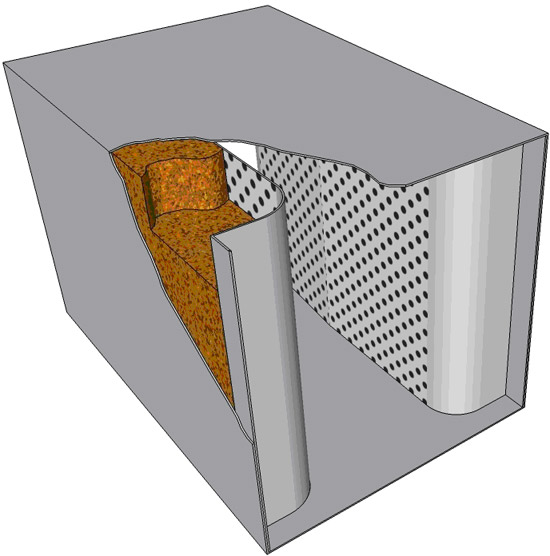 |
Kinetic cut view of rectangular silencer showing internal acoustic media, nose cone, perforated baffle face and outer solid silencer shell
Image courtesy of Kinetics Noise Control, Inc. |
Manufacturers offer a selection of standard or custom engineered silencers that will satisfy the requirements of project specific applications.
 |
Circular silencer with sound absorbing bullet and outer shell supply and return air systems
Photo courtesy of Kinetics Noise Control, Inc. |
 |
Rectangular Silencer with circular end caps and absorptive baffles.
Image courtesy of Kinetics Noise Control, Inc. |
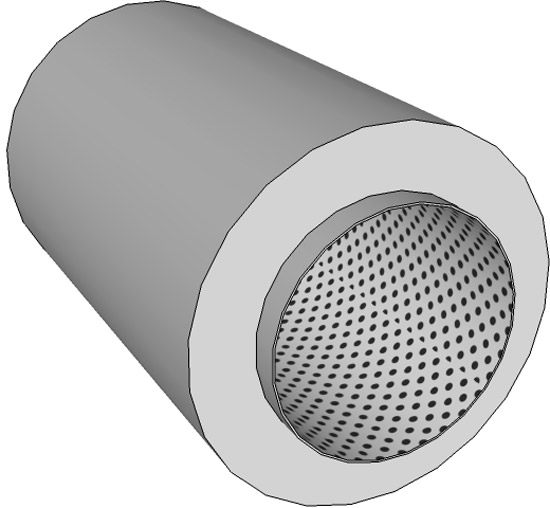 |
Circular silencer with absorptive outer casing and no sound absorbing bullet.
Image courtesy of Kinetics Noise Control, Inc. |
 |
T-rectangular elbow silencer with absorptive side baffles and curved air passages.
Image courtesy of Kinetics Noise Control, Inc. |
 |
Circular silencer with sound absorbing bullet and no absorptive outer casing
Image courtesy of Kinetics Noise Control, Inc. |
 |
Circular silencer with internal sound absorbing bullet and absorptive outer shell.
Image courtesy of Kinetics Noise Control, Inc. |
 |
Rectangular elbow silencer with extended body (casing)
Image courtesy of Kinetics Noise Control, Inc. |
Guidelines for selecting silencers
The following information is needed to determine silencer Insertion Loss (IL) and Pressure Drop (PD) performance:
• Insertion Loss (IL) requirements
• Forward (supply) or reverse (return) airflow direction
Forward flow: airflow in the silencer is in the same direction as the noise propagation
Reverse flow: airflow in the silencer is in the opposite direction to the noise propagation
• Maximum allowable silencer PD
• Airflow (cfm)
• Length, width and height restrictions for where the silencer is to be installed, connecting duct dimensions.
The IL requirements, quoted for octave bands 1 through 8 may be determined by:
• Comparison to an existing specification
• Duct system analysis.
• Application-dependent requirements, such as elimination of low frequency or tonal noise
| Example of Web-based Silencer Analysis |
By incorporating the most up-to-date design analysis algorithms recognized by ASHRAE, this example from a leading manufacturer of a no-cost software service provides a complete eight-octave band acoustic analysis The program produces a report that displays whether or not a design meets the required noise level within the critical space. If the sound levels are not met, the program will automatically choose a duct silencer that meets the required attenuation while still meeting the user specified constraints such as the application’s allowable height, width, and length and pressure loss.
|
Conclusion
Proper acoustic analysis of an HVAC duct system is an important part of any design. Design professionals should always set specific acoustic requirements and analyze the duct system design to determine how much unwanted acoustic energy (noise) is produced by the system. A correctly performed acoustic analysis will determine exactly how much noise treatment is required to provide a quiet system with the lowest initial and operating costs.
 |
Celebrating over 55 years, Kinetics Noise Control has extensive experience in designing and manufacturing innovative products to control sound and vibration. Established in 1958 as engineers focusing on sound and vibration control, Kinetics pioneered development of pre-compressed, molded fiberglass pad isolators that would be incorporated into an innovative new floor isolation system. Previous trade names of Kinetics Noise Control include Consolidated Kinetics and Peabody Noise Control. www.kineticsnoise.com |









